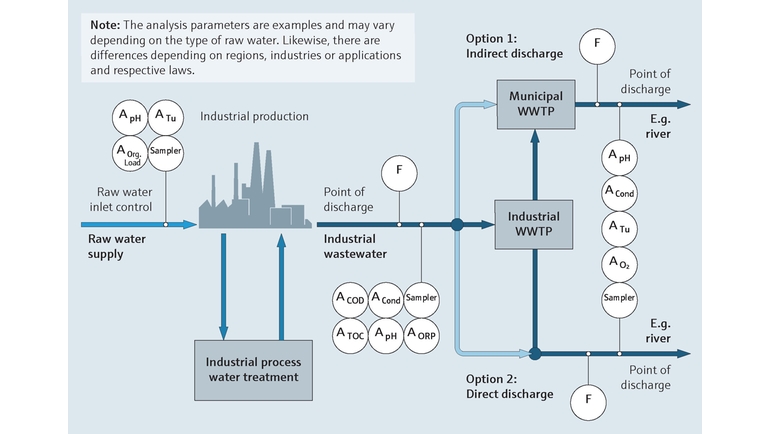Industrial Waste Water Treatment-- Effective Waste Management for Factories
Industrial Waste Water Treatment-- Effective Waste Management for Factories
Blog Article
Key Techniques in Industrial Waste Water Therapy Procedures
The treatment of industrial wastewater is an essential aspect of ecological monitoring, including a variety of methods developed to reduce the effect of pollutants. Developments in technologies such as membrane filtering and advanced oxidation procedures offer cutting-edge options for improving treatment effectiveness.
Physical Therapy Methods
Exactly how effectively can physical therapy methods resolve the intricacies of industrial wastewater? Physical therapy methods play a critical function in the preliminary stages of wastewater monitoring, focusing primarily on the elimination of solids and large particulates. Techniques such as flotation protection, sedimentation, and filtering are necessary for reducing the focus of suspended solids, therefore enhancing the effectiveness of subsequent therapy processes.
Sedimentation includes the gravitational settling of solids, permitting for the separation of much heavier products from the wastewater. This technique is especially reliable in clearing up water prior to biological or chemical treatments.
In addition, flotation techniques, which utilize air bubbles to lift put on hold solids to the surface for elimination, work in treating wastewater with high focus of fats, oils, and oils. Generally, physical therapy methods act as an important initial step in the thorough management of commercial wastewater, ensuring that the tons on succeeding therapy stages is minimized and boosting total treatment effectiveness.
Chemical Therapy Techniques
While physical therapy approaches prepared for effective wastewater administration, chemical therapy methods are vital for dealing with the extra complicated contaminants often discovered in industrial effluents. These approaches utilize different chemical agents to speed up, neutralize, or oxidize dangerous substances, making sure a much more comprehensive elimination of pollutants.
One typical approach is coagulation and flocculation, where chemical coagulants such as light weight aluminum sulfate or ferric chloride are added to advertise the aggregation of suspended fragments. This process improves solid-liquid splitting up, decreasing turbidity and boosting water top quality. Furthermore, neutralization procedures are employed to adjust the pH of wastewater, utilizing bases or acids to neutralize acidic or alkaline streams, respectively.
Oxidation-reduction responses play a crucial function in degrading natural contaminants and microorganisms. Chemical oxidants like ozone, chlorine, or hydrogen peroxide are made use of to damage down complex organic compounds, making them less dangerous or a lot more eco-friendly. Advanced oxidation processes (AOPs) combine several oxidation strategies to boost pollutant removal effectiveness.
Biological Treatment Procedures
The effectiveness of wastewater treatment is considerably enhanced by biological therapy procedures, which harness the all-natural metabolic activities of microorganisms to break down organic matter and eliminate contaminants. Industrial Waste Water Treatment. These processes mainly involve anaerobic and aerobic digestion, each customized for details kinds of wastewater
Aerobic therapy procedures use oxygen to sustain microbial growth, advertising the breakdown of natural toxins into co2 and water. Common methods consist of turned on sludge systems, where aeration storage tanks help with the mixing of wastewater with microbes, and dripping filters, which motivate biofilm advancement on media surfaces.
Conversely, anaerobic therapy processes occur in the lack of oxygen, using anaerobic bacteria to decay raw material, resulting in biogas manufacturing, a renewable resource source. Anaerobic digesters are typically employed in commercial settings for this objective, effectively reducing the quantity of sludge while generating beneficial biogas.
The choice of an organic treatment method depends upon wastewater qualities, treatment objectives, and regulatory criteria. The combination of organic processes in wastewater treatment not just enhances contaminant removal effectiveness however also advertises sustainability by reducing chemical use and sustaining resource recuperation.
Advanced Oxidation Processes

Common AOP techniques consist of Fenton's reagent, photocatalysis, and ozonation. Fenton's reagent, a mix of hydrogen peroxide and ferrous iron, catalyzes the formation of hydroxyl radicals, making it effective for dealing with wastewater including phenolic substances and other stubborn materials. Ozonation uses ozone as an effective oxidant, with the ability of degrading a vast array of natural toxins while concurrently disinfecting the effluent. Photocatalysis employs light-activated catalysts, such as titanium dioxide, to see here enhance oxidation reactions and remove contaminants.
AOPs provide numerous benefits, including decreased sludge manufacturing and the capacity to treat wastewater with high concentrations of organic contaminants. However, the execution of AOPs needs cautious factor to consider of functional criteria and cost-effectiveness, ensuring that these innovative techniques are appropriately integrated into existing wastewater treatment systems.
Membrane Filtration Technologies

Microfiltration is reliable for eliminating suspended germs and solids, while ultrafiltration targets smaller sized natural particles and infections. Nanofiltration bridges the gap between ultrafiltration and turn around osmosis, properly getting rid of divalent ions and organic compounds. Reverse osmosis supplies the highest level of filtration, made use of largely for desalination and getting rid of mono-valent ions.
Membrane innovations supply countless advantages, consisting of reduced energy usage contrasted to typical therapy approaches, modular design for scalability, and the potential for water recovery and reuse. Nevertheless, difficulties such as membrane fouling and the need for regular maintenance have to be dealt with to guarantee system effectiveness. On the whole, membrane layer filtering innovations stand for an important component of contemporary commercial wastewater treatment approaches, advertising sustainability and resource conservation in water monitoring.
Verdict
In final thought, commercial wastewater treatment uses a diverse variety of techniques, consisting of physical, chemical, organic, and advanced approaches. Continued innovations in these methodologies will better improve the effectiveness and effectiveness of wastewater therapy processes in industrial setups.
The therapy of industrial wastewater is an important aspect of environmental monitoring, involving a variety of methods created to mitigate the influence of contaminants.How efficiently can physical therapy approaches resolve the intricacies of industrial wastewater?Advanced oxidation procedures (AOPs) stand for an advanced technique in commercial wastewater therapy, created to effectively deteriorate browse around here natural toxins that are often resistant to conventional treatment techniques (Industrial Waste Water Treatment).In verdict, commercial wastewater therapy uses a diverse selection of strategies, consisting of physical, chemical, organic, and advanced methods. Proceeded advancements in these approaches will even more improve the effectiveness and effectiveness of wastewater treatment processes in commercial setups
Report this page